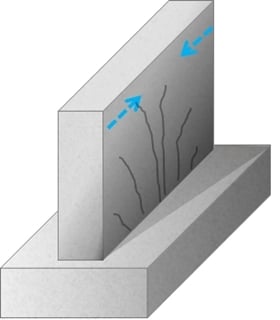The civil engineer and construction team need to know why concrete cracks at different times. There are many reasons for cracks in concrete.
It is very important to avoid cracks in the concrete as much as possible, as this will affect the durability of the structure and structural stability if the structural element cracks over a large area.
Let's look at the main reasons for this Cracks in concrete .
Why does concrete crack?
There can be many reasons for cracking in concrete and there are different types of cracks in concrete. Let's see which types of cracks in concrete are most common.
Cracking in waterproof concrete due to the following reasons
-
Plastic Cracks
- Shrinkage cracks in plastics
- Plastic settlement cracks
-
Construction movement
- Formwork movement
- Ground movement
Reasons for Cracks in Hardened Concrete
-
Physical reasons for cracks
- Shrinkable aggregates
- Dry shrinkage
- Fine cracks
-
Chemical causes of cracks in concrete – chemical adhesions in concrete
- Corrosion of reinforcements
- Alkaline aggregate reaction
- Reduction in cement carbonation
-
Thermal effects – Thermal cracking in concrete
- Freeze/thaw cycles
- Outdoor seasonal temperature fluctuations
- Early thermal contractions
- Formation of cracks in concrete due to increased core temperature, which leads to delayed ettringite formation
-
Structural design issues
- Accidental overload
- Crack Crawl
- Cracks due to incorrect design loads being taken into account
- Cracks due to incorrect construction practices
Above are the main reasons for concrete cracking at each stage. Also, let's look at some related things we need to know.


Why does new concrete crack? / Why does fresh concrete crack?
New concrete has no stiffness other than cohesion in the concrete mix. As concrete hardens, stiffness is gradually created.
As the volume of concrete decreases, cracks in the concrete may occur. These cracks can be called shrinkage cracks.
If after concreting we… Hardening of concrete Concrete can crack at the right time and at the right dosage. The following reasons can be listed as the main reasons for cracks in new concrete.
- Excessive evaporation of moisture from the concrete surface
- High temperature difference between surface and core on large concrete surfaces
- Greater temperature gradient in thick concrete.
- Insufficient reinforcement to absorb the tensile stresses that arise in raw concrete.
Why does concrete crack when it dries or Why does concrete crack when it dries
Concrete shrinks as it solidifies or hardens. This shrinkage of the concrete leads to the development of tensile stresses in the concrete. These tensile stresses lead to the formation of cracks in the concrete.
This type of concrete cracking could be avoided by providing sufficient reinforcement to absorb the stress created in the concrete.
Additionally, as concrete dries, the water contained in the concrete evaporates. Evaporation reduces the volume of concrete and its load-bearing capacity, which creates tensile stresses. In this way, cracks known as dry shrinkage cracks are formed.
Why do concrete slabs crack? Why do concrete floors crack?
The concrete slab is generally not a thick element. The temperature of the concrete does not increase much. Therefore, cracking in concrete is less likely due to thermal effect.
However, it is possible for concrete to dry out due to external temperature rise. Therefore, drying shrinkage cracks may occur.
Insufficient hardening of the concrete slab can cause such cracks.
Furthermore, if the thickness of the slab is greater than 200 mm, cracks may appear in the concrete due to thermal effects. Sufficient reinforcement can be provided to prevent cracking.
Why does self leveling concrete crack?
In general, fluid concrete is also a type of concrete that has almost similar properties to other types of concrete. A special feature is the self-leveling ability.
The workability of self-leveling concrete is greater. This can be done by increasing the water content or by adding a water-reducing agent to the mixture .
Increased evaporation rate and increased shrinkage during drying can be reasons for cracks in self-leveling concrete.
By clarifying, you can find out why concrete cracks.
Cracks in concrete can be inevitable. However, we must not allow the concrete to crack in a way that compromises the structure's durability and structural stability.
Related articles
- Early thermal cracking (calculate R/F requirements)
- Influence of construction practices on the formation of cracks
- Formation of cracks in concrete (basics, types and causes)
- Physical reasons for cracks
- Basics of crack formation in immature concrete
- Types of Foundation Cracks, Why They Are Serious
- Basement Wall Cracks (A Detailed Study)
- What is concrete spalling – causes and repairs
- 20 factors that affect the durability of concrete
- Durability of concrete (requirements and problems)
- Concrete shaking (methods and correct procedure)
- 6 Factors That Affect Concrete Curing Time
- 11 Methods for Curing Concrete
- A detailed study of concrete (from scratch)
- Types of concrete shrinkage (detailed study)

